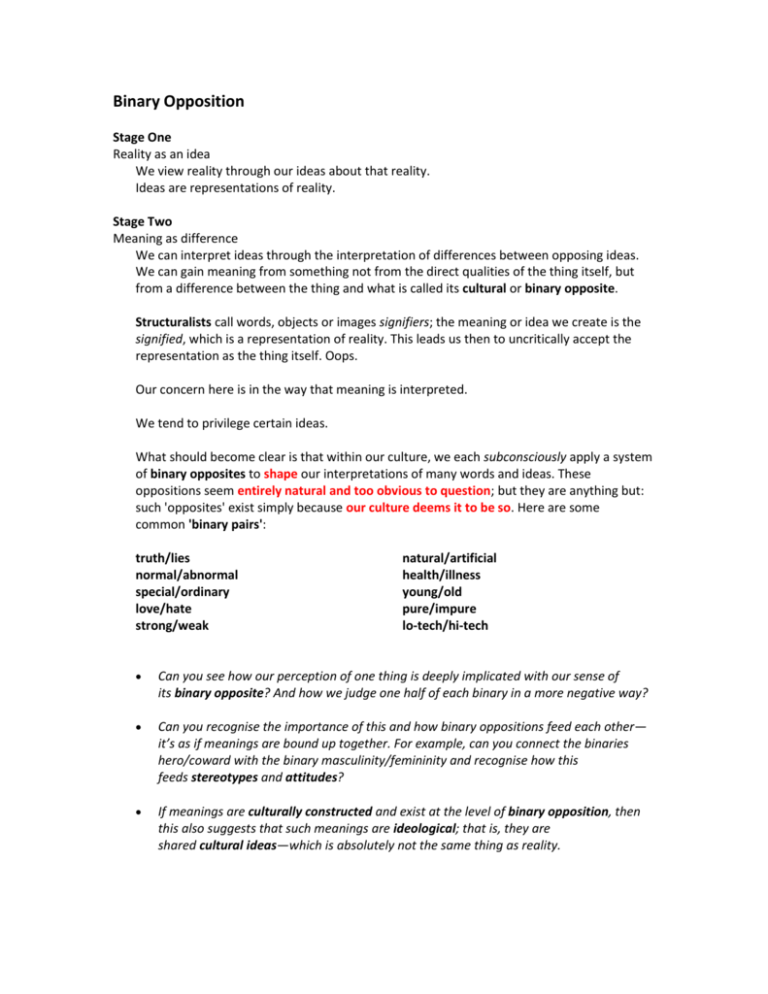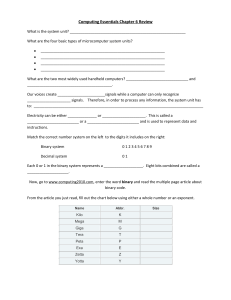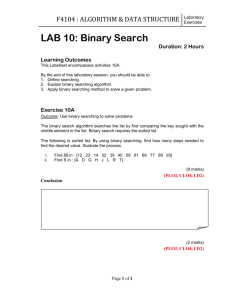Binary Opposition: Structuralism & Meaning
advertisement

Binary Opposition Stage One Reality as an idea We view reality through our ideas about that reality. Ideas are representations of reality. Stage Two Meaning as difference We can interpret ideas through the interpretation of differences between opposing ideas. We can gain meaning from something not from the direct qualities of the thing itself, but from a difference between the thing and what is called its cultural or binary opposite. Structuralists call words, objects or images signifiers; the meaning or idea we create is the signified, which is a representation of reality. This leads us then to uncritically accept the representation as the thing itself. Oops. Our concern here is in the way that meaning is interpreted. We tend to privilege certain ideas. What should become clear is that within our culture, we each subconsciously apply a system of binary opposites to shape our interpretations of many words and ideas. These oppositions seem entirely natural and too obvious to question; but they are anything but: such 'opposites' exist simply because our culture deems it to be so. Here are some common 'binary pairs': truth/lies normal/abnormal special/ordinary love/hate strong/weak natural/artificial health/illness young/old pure/impure lo-tech/hi-tech Can you see how our perception of one thing is deeply implicated with our sense of its binary opposite? And how we judge one half of each binary in a more negative way? Can you recognise the importance of this and how binary oppositions feed each other— it’s as if meanings are bound up together. For example, can you connect the binaries hero/coward with the binary masculinity/femininity and recognise how this feeds stereotypes and attitudes? If meanings are culturally constructed and exist at the level of binary opposition, then this also suggests that such meanings are ideological; that is, they are shared cultural ideas—which is absolutely not the same thing as reality. So, for structuralists, meaning is created in the difference between two binary opposites and at the level of an ideological cultural idea. These ideas are learned and absorbed as we grow up within our particular culture. Of course, we see them not as what they are, cultural constructs, but as 'real', 'natural' or 'obvious' –as, quite simply, too obvious to question. Assignment Create a visual representation for the ideas in this section. Stage Three Hierarchy of values It seems it is natural (or is it cultural...?) to judge one thing's meaning against another 'connected' thing's meaning and to place the meanings within some kind of 'hierarchy of value'. Identify which binary is viewed most positively and explain why. strong weak calm moody dominant submissive tough gentle active passive logical emotional mind body aggressive peaceful It's very important not to see these labels as real. As with all meaning, they can exist only as cultural ideas, i.e. as ideologies. They can certainly be said to represent reality but such labels can never be more than a version of reality. This is why they are ideological—they act to reinforce judgmental and hierarchical ways of thinking that might well seem entirely natural, but which are anything but. You can perhaps now begin to see how binary pairs can be extraordinarily powerful in reinforcing and maintaining a society's ways of thinking. An interesting question to ask of a binary pair is who in society ultimately benefits from people 'thinking that way'? Another question is to ask who in society works to reinforce such binaries and why? Create your own self narrative. - photograph yourself every day - leave a trace of your activities





